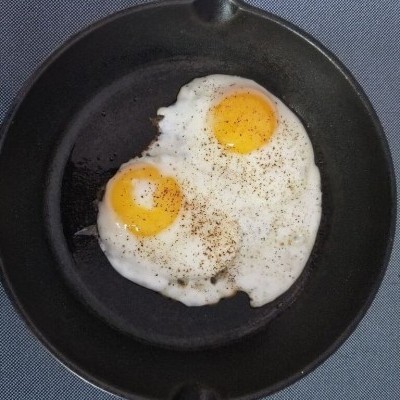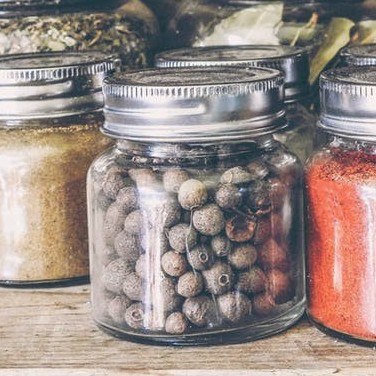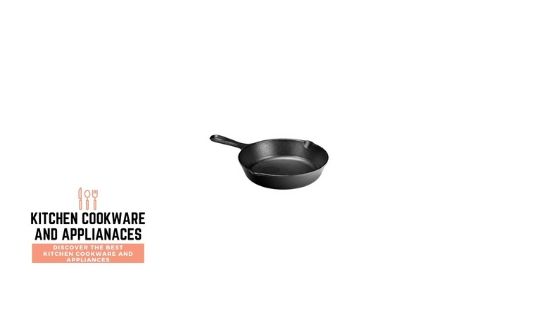While cooking some plant based burgers the other day I found myself paying close attention to the design of my skillet. A little skillet seemingly plain and boring. The endless possibilities showcase how a simple design can be reliable. So how did I go from thinking that this was simply a nice addition that came with a set, to becoming my favorite out of the whole set?
One of the five out of a cast iron cookware set. It became my go to skillet for individual servings. This led to me using my Lodge 8 inch cast iron skillet more frequently than the rest of the set. Originally I was under the impression that the more you use cast iron cookware the more you will need to season it. This was not the case at all. Use cast iron cookware properly and you will end up establishing your seasoning instead of destroying it. Learning how to do this is easy especially for this tiny skillet.
In this review we will be focused about the ease of use and care for this skillet. For those who are on the fence about cast iron cookware the Lodge 8 inch cast iron skillet serves as a wonderful introduction into cooking with cast iron cookware.
What to do the First Time it is Used
If this is your first time using cast iron skillet fear not, no learning curve here. For any new cast iron cookware you are going to want to avoid cooking anything that is high in acidic content such as tomatoes, onions and peppers. Since this is a small skillet the options are limited to it’s size.
Eggs are a great method of testing the skillet for the first time just add an approiate amount of cooking oil (just enough to cover the surface) before doing so. When I first tried my Lodge 8 inch skillet I cooked up some sunny side up eggs. It sounds risky to do but I was confident that I could do it. Pre-heated to the right temperature and oiled with the right amount of oil ensures a smooth operation.

Since then I have continued to put my skillet to work for all kinds of purposes and will continue to do so until I can’t any more. Have no fear or hesitation when cooking your foods try to have fun with it. This type of mentality makes everything so much easier and by no time you can dish out whatever your heart desires with ease.
How to Take Care of Your Seasoning
 The part that makes the skillet non-stick is the seasoning a layer of oil bonded by heat. No salt or spices involved. Anytime you receive a new cast iron cookware tool it will come already seasoned.
The part that makes the skillet non-stick is the seasoning a layer of oil bonded by heat. No salt or spices involved. Anytime you receive a new cast iron cookware tool it will come already seasoned.
Most manufacturers will use vegetable oil of some sort. In some cases they will use the very popular but expensive flax-seed oil. Lodge uses vegetable oil for their season. Some people prefer to get rid of the seasoning that comes with the cast iron and replace it with their own cooking oil of choice.
I prefer to leave on the season that comes with my cast iron cookware. Though going forward I season it with Chosen Foods refined avocado oil because of it’s high smoke point.
Care for the seasoning is simple and important to learn so you can successfully establish the seasoning. An established seasoning will be far better off at providing a non-stick barrier on the surface when compared to a brand new seasoning.
After every use of the skillet it has to be cleaned. How it is cleaned is subject to your own preference despite what is discussed here. Cleaning the skillet with an SOS pad makes for a quick and easy way to scrub off any excess food particles.
Keep in mind when using SOS pads the complex flavor built up over time will be cleaned off in the process. The SOS pad will scrub off the food but not the seasoning when scrubbed gently. When first using the L5SK3 or Lodge 8 inch cast iron skillet I recommend using a pan scrapper once the skillet has cool down.
This will allow the seasoning the opportunity to slowly establish with each use. Once the seasoning is established a gentle scrub with a SOS pad makes for an quick an easy cleaning method. When the skillet is free of any food scraps dry off promptly with a lint-less rag. Set on a low setting on one of the stove tops heating elements in order to evaporate any remaining water. Any oil left on the surface will adhere to the surface and bond onto what seasoning you had on previously. Though a gradual process bonding layers on top of the other over time does add up and create a better more consistent non-stick layer.
Establishing the Non-stick Layer
You could go a step further and allow the surface to cool down after evaporating any remaining water. Then you can apply a small amount of your cooking oil of choice and rub it onto the entire skillet. Repeat the same as before set a heating element on a low setting and let the skillet heat up.
The cooking oil you used to lather all over the skillet will stick to the surface through bonding. Whether or not this extra step of seasoning is done or not, each time you use your skillet your seasoning will become more established. This means a better non-stick property and added flavor overtime.
Destroying the Seasoning
In case you want to start a new with a fresh strip of seasoning or you want to restore your skillet it will involve abrasion and steel. Depending on the condition of the surface you may have to use a steel wool drill bit and a drill to scrub away any rust. This can also be made to make a smooth surface completely destroying any seasoning previously bonded.
Depending on the severity of the oxidization or dirt all you need is a steel wool pad and a drop of light dishsoap. Scrub away until you see bare grey cast iron. Learn how to season in the oven with our guide here. The same care and maintenance methods used for one cast iron cookware tool can be used for all.
Remember it’s your seasoning and how or what you use to maintain it is subject to your own preference with the exception of Easy-Off or any other harsh or caustic cleaning solution. They are meant for cleaning other cooking surfaces.
The stigma that cast iron cookware is difficult to deal with and barely non-stick is simply not true. When proper use and care procedures have been followed you can count on cast iron cookware as a reliable tool in your kitchen or even at a campfire. Never use cast iron in the microwave it is the only surface that cast iron is not intended for which is good because not many flavorful dishes come from the microwave.
A mundane topic no doubt. Did you learn anything new about cast iron skillets? If you did feel free to chime in on the comments section below. Any further related comments or questions are always welcome as well.
Lodge 8 Inch Cast Iron Skillet Rating
-
Design - 9/109/10
-
Function - 9/109/10
-
Longevity - 9/109/10
Lodge 8 Inch Cast Iron Skillet Rating
Product: Lodge 8 Inch Cast Iron Skillet
Product Description: Lodge’s version of a 8 inch cast iron skillet. Small by design it makes a great addition for some kitchens. Cast iron is very long-lasting, it can take a drubbing and still be fully functional. With proper use and care this cast iron skillet can easily last several generations within a family. The material has great heat retention. Keep what you make on this skillet warm while you work on making other dishes.
Availability: Check local retailer for availability.

